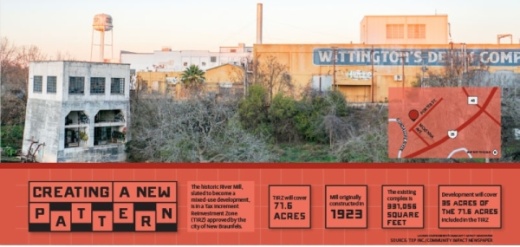In 2017, local developer Don Thomas of Reata Real Estate Services, which is now part of CBRE Inc., purchased the 35-acre property on which the mill and several other properties sit.
The city of New Braunfels approved its second tax increment reinvestment zone, or TIRZ, in November 2019 for the 71.6-acre area in and around what is currently known as the Milltown district. The TIRZ includes Thomas’ property and would contribute funding for the site’s redevelopment.
A TIRZ allows a city to capture projected increases in sales and property tax revenue created by a development within a defined area and then reinvest those funds into public improvements and projects within that zone.
Thomas plans to break ground in late fall 2020, and he hopes to incorporate residential and retail space into the River Mill development to spur a revitalization of Milltown.
“There’s a lot of history there,” Thomas said. “I want to make it something that’s contributing to the neighborhood.”
History of River Mill
Built in 1923 by Planters & Merchants Mill, the mill was a major source of jobs for the community, said Amy McWhorter, New Braunfels’ historic preservation officer. According to McWhorter, the mill was the largest employer in Comal County for most of its history.
“You had different layers of generations and family relationships working at the mill,” said Yvonne Hoffmann, a New Braunfels resident and Realtor with Reliance Residential Realty.
Hoffmann’s ancestors were one of New Braunfels’ founding families. She remembers visiting the mill as a child to learn about textile manufacturing.
“They would take us all through the mill,” Hoffmann said. “If you were in home economics, your teacher would take you there and you would either pick a pattern or bring one with you and decide what you wanted to make.”
The mill was known for its denim and cotton products. It opened a retail store in the 1940s where consumers could purchase fabric directly, Hoffmann said.
The mill has traded hands numerous times through its history. According to Sophienburg Museum & Archive’s website, the mill came under new ownership in 1931 and was renamed New Braunfels Textile Mills before being bought by Mission Valley Mills.
Mission Valley Mills then became a division of WestPoint Pepperell in 1972 before Mission Valley Textiles Inc. was formed through a leveraged buyout, McWhorter said.
Finally, the Plains Cotton Cooperative Association purchased the mill in 1998 and operated there until its closure in 2005.
“The town kind of revolved around the mill,” Hoffmann said. “It was the major employer for a long time.”
After the mill closed, the facility has sat vacant and was purchased in August 2017 by Thomas.
Developing the district
Thomas said planning for the mixed-use development and the search for funding began after he purchased the property.
“Folks are wondering what’s going on with it,” said Jeffrey Jewell, New Braunfels’ director of economic and community development. “The longer these properties sit vacant, the harder they become to redevelop.”
As part of New Braunfels’ 2017 Economic Development Strategic Plan, the city committed to a redevelopment strategy for the Milltown District, Jewell said. According to Jewell, the district qualifies as a distressed census tract and is a deemed an underperforming property.
“The city certainly has an interest in making sure that when the opportunity is right, that real estate is productive from a tax revenue perspective,” Jewell said.
As a way of bolstering revitalization efforts, New Braunfels City Council elected to create the city’s second TIRZ. The existing zone is the Creekside TIRZ created in 2007.
According to city documents, the area included in the Creekside TIRZ has seen significant growth and includes Town Center at Creekside, which is also a mixed-use development that includes retail and residential space.
During the 2018-19 fiscal year, the TIRZ received a total of $5,188,871 in property and sales tax, according to city reports.
A report by Travis James, vice president of TXP, suggests the TIRZ would provide up to $16 million toward the TIRZ over the zone’s projected 25-year lifespan.
James estimates the mill development will cost more than $100 million.
“The TIRZ will help the developer transfer it to what it will be,” James said. “The positive impact on the community will be the transition from what it is now.”
While a TIRZ does direct tax revenue toward specific projects, it does not cause tax increases, James said. Projects funded through the TIRZ could include infrastructure improvements and maintenance costs.
“This is exactly what tax increment financing is for,” Jewell said. “It’s to direct flow into underserved, underinvested communities.”
As Thomas solidifies his plans and more data becomes available, the expected revenue from the TIRZ will be adjusted accordingly.
Moving forward
The project could include a boutique hotel, multifamily units, restaurants, retail and office space, according to Thomas. He also hopes to adapt and reuse as many existing structures as possible to maintain the historical integrity of the property.
“We want to figure out how much of the existing structures we can use,” Thomas said. “We have to determine what’s the right formula.”
According to Jewell, the use of the property as a mixed-use development is indicative of a common trend throughout the country.
“Retail is changing,” Jewell said. “People are putting a lot more emphasis on place and having amenities that are distinct and unique to your community.”
Many community members hope that the development will capture the significance of the original mill.
“I hope to see something that will help our economy thrive and be something we all are proud of and enjoy going to,” Hoffmann said. “Something that will bring back the vibrancy and the energy that the mill represented.”







